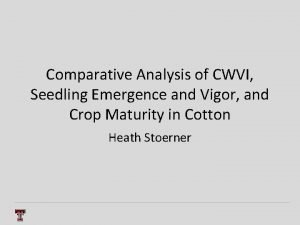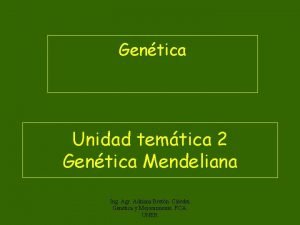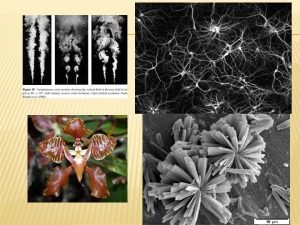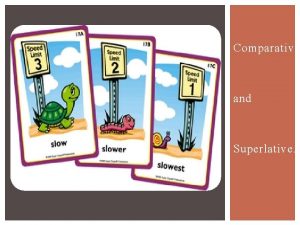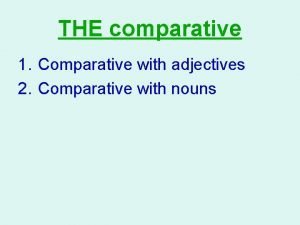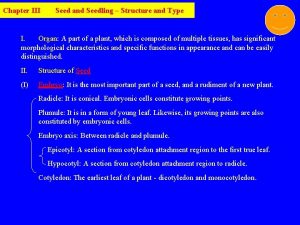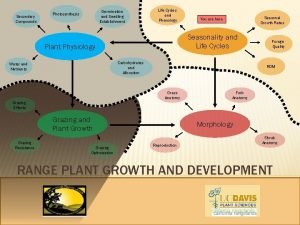Comparative Analysis of CWVI Seedling Emergence and Vigor





























- Slides: 29

Comparative Analysis of CWVI, Seedling Emergence and Vigor, and Crop Maturity in Cotton Heath Stoerner

Introduction Upland cotton (Gossypium hirsutum L. ) has adapted very well to the Texas High Plains. Many of the requirements needed for cotton production are met. However, a short growing season, usually 120 to 150 days, can sometimes cause limitations. The development rate of cotton is strongly influenced by temperature. A cotton crop grows more slowly on cool days than on warm days. Low early season temperatures can drastically reduce seedling emergence and vigor. A slower rate of emergence is frequently associated with low-vigor seed which will result in smaller plants (in comparison with high vigor seed)(Tekroney and Egli, 1990).

Introduction Results from a seed germination test performed in a seed germinator were compared to a field test, in which seedling vigor, plant maturity, fiber analysis, and yield data were taken. Results from this study can be used to help producers better predict field performance using vigor tests. Producers can use vigor tests to help decide on planting dates, planting rates and planting depths.

Introduction Cotton breeders can evaluate how a germplasm will perform in the field when seed quantity numbers are limited. Vigor potential of a particular variety is initially established at the genetic level. Seed companies can use vigor tests to evaluate various environmental conditions and the effect they have on resulting seed quality.

Introduction Gregory et al. (1986) showed good correlations between the cool-warm vigor index(CWVI) test and initial stand establishment. Metzer (1987) reported results from the cool-warm vigor index(CWVI) test was a good indicator of final stand taken 6 weeks after planting. In this study we hypothesized a relationship between the cool-warm vigor index(CWVI) and early season cotton maturity and vigor.

Cool-Warm Vigor Index Seed vigor of each variety was obtained using the coolwarm vigor index test (CWVI). The test was run using a Percival seed germinator. 50 seeds of each variety are rolled in moist germination towels and replicated 4 times. This index is a combination of the standard warm germination test and the cool germination test which is also known as the Texas Cool Test. For the warm germination test, seeds are held at 20°C for 16 hours and 30°C for 8 hours daily for 4 days. This test is conducted under optimum conditions, and will only predict field emergence under optimum conditions.

Cool-Warm Vigor Index During the cool germination test, seeds are held at a constant 18°C for 7 days. Seeds that have a combined roothypocotyl length of 4 cm long are counted. Numerical values from the warm germination test and the cool germination test are combined to give the cool-warm vigor index.

Cool-Warm Vigor Index

24 Varieties Tested in 2006 DP 117 B 2 RF DP 143 B 2 RF DP 164 B 2 RF DP 432 R DP 444 BR DP 555 BR FM 9060 F FM 9063 B 2 RF FM 960 B 2 R FM 960 BR FM 960 R NG 1553 R NG 2448 R NG 3273 B 2 RF NG 3550 RF NG 3969 R ST 4357 B 2 RF ST 4554 B 2 RF ST 4575 BR ST 4646 B 2 R ST 4686 R ST 5242 BR ST 6565 B 2 RF STX 0501 RF

30 Varieties Tested in 2007 DP 117 B 2 RF DP 143 B 2 RF DP 147 RF DP 164 B 2 RF DP 444 BR DP 445 BGRR FM 9058 F FM 9063 B 2 RF FM 960 B 2 R MX 0610 B 2 RF MX 0613 B 2 RF MX 0616 B 2 RF NG 1553 R NG 1572 RF NG 2448 R NG 3273 B 2 RF NG 3550 RF NG 3969 RR ST 4357 B 2 RF ST 4427 B 2 RF ST 4554 B 2 RF ST 5327 B 2 RF STX 0626 B 2 R STX 0627 B 2 RF STX 0710 B 2 RF STX 0711 B 2 RF STX 0712 B 2 RF STX 0721 RF STX 0722 RF STX 0723 RF

Cool-Warm Vigor Index

Cool-Warm Vigor Index Gregory et al. 1986.

Methods and Materials 160 plants were planted per plot using a randomized block design. 24 varieties using 3 replications at 2 locations was planted in 2006. Texas Tech New Deal research farm had a May 11, 2006 planting date. Texas Tech Quaker research farm had a May 13, 2006 planting date.

Methods and Materials 30 varieties using 3 replications at 1 location was planted in 2007. Planted at the Texas Tech Quaker Research farm on May 17, 2007. A sub-surface drip irrigation system was used and managed for maximum yield potential.

Methods and Materials Plant emergence and vigor were determined by counting plants and categorizing into emerged, first, second, third, and fourth leaf stages. A plant vigor index was established from this data. This was performed 16 times from emergence until the fourth leaf stage in 2006 and 12 times in 2007.

Methods and Materials

Methods and Materials August 7, 2006 Texas Tech New Deal Research Farm

Methods and Materials October 27, 2006 Texas Tech New Deal Research Farm

Methods and Materials Nodes above white flower as well as nodes above cracked boll were also recorded for crop maturity determination. Yield data on each plot was taken with a mechanical harvester. 50 boll samples from each plot were ginned using a 10 saw gin and fiber quality analysis was performed by the International Textile Center.

Results Analysis was performed using a PROC MIXED procedure. CWVI p-value = <. 0001 NACB p-value = <. 0001 P-values between leaf number by variety = <. 0001 Micronaire p-value =. 0301

Results 2006 Graphs showing correlations between CWVI and plant vigor.

Results 2006

Results 2006

Results 2007

Results 2007

Conclusions • The cool-warm vigor index test does show relationship to early season plant maturity and vigor. • This test can be used to predict how well a particular variety will perform early in the growing season. • Some relationship was found between late season maturity data (NACB) and cool-warm vigor index. • No correlation was found when the cool-warm vigor index test was compared to fiber maturity(micronaire) and yield data taken later in the growing season.

Conclusions • Glat et al. (1982) noted that there have been many attempts to correlate seed vigor and yield and many have failed. Our data supports this as well. • This could be due to the cool-warm vigor test only being able to measure a limited number of factors, which may not be the same stresses that the seed may encounter during a growing season.

References • Glat, D. , B. B. Taylor, and M. D. Williams, 1982. The relationship of predictive tests for planting seed quality and field performance. Proc. Cotton Prod. Res. Conf. 1982: 65 -67. • Gregory, J. , N. Hopper, and G Jividen. 1986. Evaluation of several laboratory tests for determining cottonseed quality. Proc. Cotton Prod. Res. Conf. 1986: 62 -63. • Metzer, R. B. 1987. Seed vigor index-field emergence relationships. Proc. Cotton Prod. Res. Conf. 1987: 130 -131 • Percival, A. E. , J. F. Wendel, and J. M. Stewart. 1999. Taxonomy and Germplasm Resources. in Cotton: Origin, History, Technology, and Production. W. C. Smith and J. T. Cothren eds. John Wiley and Sons, Inc. , New York, NY. • Tekroney, D. M. and D. B. Egli, . 1990. Relationship of seed vigor to crop yield: A Review. Crop Sci. 31: 816 -822(1991)

Acknowledgements • • Dr. Craig Bednarz Cory Mills Even Maxwell Seth Sowder Chris Griffin Lu Feng Daniel Olivier
 Cwvi
Cwvi Parts of a red bean seed
Parts of a red bean seed Seedling
Seedling Vigor 2912
Vigor 2912 Comern
Comern Vigor 3300
Vigor 3300 Vigor safety planning
Vigor safety planning Ley de la combinación independiente
Ley de la combinación independiente Vigor 3300
Vigor 3300 So&e
So&e Emergence theory
Emergence theory Lesson 2 the emergence of mass society
Lesson 2 the emergence of mass society Ion storm
Ion storm Speech emergence stage activities
Speech emergence stage activities Emergence of scaling in random networks
Emergence of scaling in random networks Preproduction early production speech emergence
Preproduction early production speech emergence Plan emergence madagascar 2019-2023 pdf
Plan emergence madagascar 2019-2023 pdf Emergence netflix
Emergence netflix Entrepreneurship during post independence
Entrepreneurship during post independence The emergence of new values
The emergence of new values Plan emergence madagascar 2019-2023
Plan emergence madagascar 2019-2023 Itero göteborg
Itero göteborg Paul ruthman committee
Paul ruthman committee Mass society
Mass society Write the superlative form
Write the superlative form Introduction of comparative education
Introduction of comparative education Causal-comparative
Causal-comparative How to write a comparative study
How to write a comparative study Methods of comparing alternatives in engineering economy
Methods of comparing alternatives in engineering economy Comparative analysis
Comparative analysis
